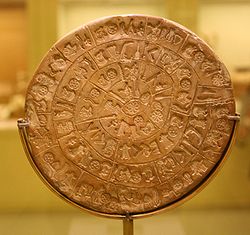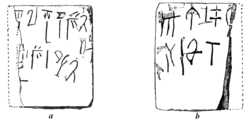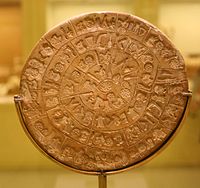- Phaistos Disc
-
Phaistos Disc
The Phaistos Disc (side A)Material Clay Created 2nd millennium BC Discovered July 3, 1908 at Phaistos, Crete, by Luigi Pernier Present location Heraklion Archaeological Museum, Crete, Greece The Phaistos Disc (also spelled Phaistos Disk, Phaestos Disc) is a disk of fired clay from the Minoan palace of Phaistos on the Greek island of Crete, possibly dating to the middle or late Minoan Bronze Age (2nd millennium BC). It is about 15 cm (5.9 in) in diameter and covered on both sides with a spiral of stamped symbols. Its purpose and meaning, and even its original geographical place of manufacture, remain disputed, making it one of the most famous mysteries of archaeology. This unique object is now on display at the archaeological museum of Heraklion.
The disc was discovered in 1908 by the Italian archaeologist Luigi Pernier in the Minoan palace-site of Phaistos, and features 241 tokens, comprising 45 unique signs, which were apparently made by pressing pre-formed hieroglyphic "seals" into a disc of soft clay, in a clockwise sequence spiraling towards the disc's center.
The Phaistos Disc captured the imagination of amateur and professional archeologists, and many attempts have been made to decipher the code behind the disc's signs. While it is not clear that it is a script, most attempted decipherments assume that it is; most additionally assume a syllabary, others an alphabet or logography. Attempts at decipherment are generally thought to be unlikely to succeed unless more examples of the signs are found, as it is generally agreed that there is not enough context available for a meaningful analysis.
Although the Phaistos Disc is generally accepted as authentic by archaeologists, a few scholars have forwarded the opinion that the disc is a forgery or a hoax.
Contents
Discovery
The Phaistos Disc was discovered in the Minoan palace-site of Phaistos, near Hagia Triada, on the south coast of Crete;[1] specifically the disc was found in the basement of room 8 in building 101 of a group of buildings to the northeast of the main palace. This grouping of 4 rooms also served as a formal entry into the palace complex. Italian archaeologist Luigi Pernier recovered this remarkably intact "dish", about 15 cm in diameter and uniformly slightly more than one centimetre in thickness, on 3 July 1908 during his excavation of the first Minoan palace.
It was found in the main cell of an underground "temple depository". These basement cells, only accessible from above, were neatly covered with a layer of fine plaster. Their content was poor in precious artifacts but rich in black earth and ashes, mixed with burnt bovine bones. In the northern part of the main cell, in the same black layer, a few inches south-east of the disc and about twenty inches above the floor, linear A tablet PH-1 was also found. The site apparently collapsed as a result of an earthquake, possibly linked with the explosive eruption of the Santorini volcano that affected large parts of the Mediterranean region in mid second millennium BC.
Authenticity
The Phaistos Disc is generally accepted as authentic by archaeologists.[2] The assumption of authenticity is based on the excavation records by Luigi Pernier. This assumption is supported by the later discovery of the Arkalochori Axe with similar but not identical glyphs.[3]
The possibility that the disc is a 1908 forgery or hoax has been raised by two or three scholars.[4][5][6] According to a report in The Times the date of manufacture has never been established by thermoluminescence.[7] In his 2008 review, Robinson does not endorse the forgery arguments but argues that "a thermoluminescence test for the Phaistos Disc is imperative. It will either confirm that new finds are worth hunting for, or it will stop scholars from wasting their effort."[4]
Dating
Yves Duhoux (1977) dates the disc to between 1850 BC and 1600 BC (MMIII) on the basis of Luigi Pernier's report, which says that the Disc was in a Middle Minoan undisturbed context. Jeppesen (1963) dates it to after 1400 (LMII-III). Doubting the viability of Pernier's report, Louis Godart (1990) resigns himself to admitting that archaeologically, the disc may be dated to anywhere in Middle or Late Minoan times (MMI-LMIII, a period spanning most of the 2nd millennium BC). J. Best (in Achterberg et al. 2004) suggests a date in the first half of the 14th century BC (LMIIIA) based on his dating of tablet PH 1.
Typography
The inscription was apparently made by pressing pre-formed hieroglyphic "seals" into the soft clay, in a clockwise sequence spiraling towards the disc's center. It was then fired at high temperature. The unique character of the Phaistos Disc stems from the fact that the entire text was inscribed in this way, reproducing a body of text with reusable characters.
The German typesetter and linguist Herbert Brekle, in his article "The typographic principle" in the Gutenberg-Jahrbuch, argues that the Phaistos Disc is an early document of movable type printing, since it meets the essential criteria of typographic printing, that of type identity:
An early clear incidence for the realization of the typographic principle is the notorious Phaistos Disc (ca. 1800–1600 BC). If the disc is, as assumed, a textual representation, we are really dealing with a "printed" text, which fulfills all definitional criteria of the typographic principle. The spiral sequencing of the graphematical units, the fact that they are impressed in a clay disc (blind printing!) and not imprinted are merely possible technological variants of textual representation. The decisive factor is that the material "types" are proven to be repeatedly instantiated on the clay disc.[8]As a medieval example for the same technique he goes on to cite the Prüfening dedicatory inscription.[9][10]
In his work on decipherment, Benjamin Schwartz also refers to the Phaistos Disc as "the first movable type".[11]
In his popular science book Guns, Germs and Steel, Jared Diamond describes the disc as an example of a technological advancement that did not become widespread because it was made at the wrong time in history, and contrasts this with Gutenberg's printing press.[12]
Inscription
Signs
There are 241 tokens on the disc, comprising 45 unique signs. Many of these 45 signs represent easily identifiable every-day things. In addition to these, there is a small diagonal line that occurs underneath the final sign in a group a total of 18 times. The disc shows traces of corrections made by the scribe in several places. The 45 symbols were numbered by Arthur Evans from 01 to 45, and this numbering has become the conventional reference used by most researchers. Some symbols have been compared with Linear A characters by Nahm,[13] Timm,[3] and others. Other scholars (J. Best, S. Davis) have pointed to similar resemblances with the Anatolian hieroglyphs, or with Egyptian hieroglyphs (A. Cuny). In the table below, the character "names" as given by Louis Godart (1995) are given in upper case; where other description or elaboration applies, they are given in lower case.
№ Sign UCS Phaistos Disc Sign (Godart and UCS name) Description Count Remarks 01 
Wikimedia Foundation. 2010.
Look at other dictionaries:
Phaistos Disc decipherment claims — There are a large number of claims of decipherment of the Phaistos Disc.The claims may be categorized into linguistic decipherments, identifying the language of the inscription, and non linguistic decipherments. A purely ideographical reading is… … Wikipedia
Phaistos — ( el. Φαιστός), also transliterated as Phaestos, Festos and Phaestus is an ancient city on the island of Crete. Phaistos was located in the south central portion of the island, about 5.6 kilometres from the Mediterranean Sea. It was inhabited… … Wikipedia
Phaistos (Diskos) — Der Diskos von Phaistos (griechisch Δίσκος της Φαιστού, auch Diskos von Phaestos oder Diskos von Festos), eine Scheibe aus gebranntem Ton, ist eines der bedeutendsten Fundstücke aus der Bronzezeit. Der Diskos von Phaistos ist mit spiralförmig… … Deutsch Wikipedia
Disque de Phaistos — faces B et A du Disque de Phaistos Le disque de Phaistos ou disque de Phaestos est un disque d argile cuite découvert en 1908 par l archéologue italien Luigi Pernier sur le site archéologique du palais minoen de Phaistos, en Crète. Il pourrait… … Wikipédia en Français
Diskos von Phaistos — Der Diskos von Phaistos (griechisch Δίσκος της Φαιστού, auch Diskos von Phaestos oder Diskos von Festos), eine Scheibe aus gebranntem Ton, ist eines der bedeutendsten Fundstücke aus der Bronzezeit. Der Diskos von Phaistos ist mit… … Deutsch Wikipedia
Diskos von Phaistós — Der Diskos von Phaistos (griechisch Δίσκος της Φαιστού, auch Diskos von Phaestos oder Diskos von Festos), eine Scheibe aus gebranntem Ton, ist eines der bedeutendsten Fundstücke aus der Bronzezeit. Der Diskos von Phaistos ist mit spiralförmig… … Deutsch Wikipedia
Unicode-Block Diskos von Phaistos — Der Unicode Block Phaistos Disc Symbols (Diskos von Phaistos) (101D0–101FF) enthält 46 Zeichen für die Stempelzeichen des Diskos von Phaistos (griechisch Δίσκος της Φαιστού), einer Scheibe aus gebranntem Ton aus der Bronzezeit. Die Stempelzeichen … Deutsch Wikipedia
Disco de Festos — Saltar a navegación, búsqueda El disco de Phaistos El disco de Festo (o disco de Phaistos) es un curioso hallazgo arqueológico de finales de la edad de bronce. Fue descubierto el 15 de julio de 1908 por el arqueólogo italiano Luigi Pernier en … Wikipedia Español
Фестский диск — Фестский диск уникальный памятник письма, предположительно минойской культуры эпохи средней или поздней бронзы. Его точное назначение, а также место и время изготовления достоверно неизвестны. Некоторые учёные подвергают сомнению его… … Википедия
Movable type — For the weblog software, see Movable Type. Part of a series on the History of printing … Wikipedia








